Workplace Health and Wellbeing in the Construction Industry Report
VerifiedAdded on 2020/04/15
|12
|2759
|368
Report
AI Summary
This report delves into the critical aspects of workplace health and wellbeing, emphasizing the importance of organizational health and safety. It highlights the legal framework for workplace safety, including the roles of managers and supervisors in adhering to occupational health and safety standards. The report focuses on stress-related injuries, outlining the detrimental effects of workplace stress on productivity, absenteeism, and employee morale, specifically within a construction company context. It explores various stress reduction strategies, such as clinical leadership, risk assessment, and redesigning the work environment, referencing NHS guidelines and HSE management standards. The report also examines the impact of employee health and wellbeing on organizational business, emphasizing the benefits of a healthy workforce, including reduced recruitment costs, improved productivity, and enhanced employee engagement. It concludes by underscoring the significance of proactive measures to promote employee health and wellbeing to foster organizational growth and productivity.
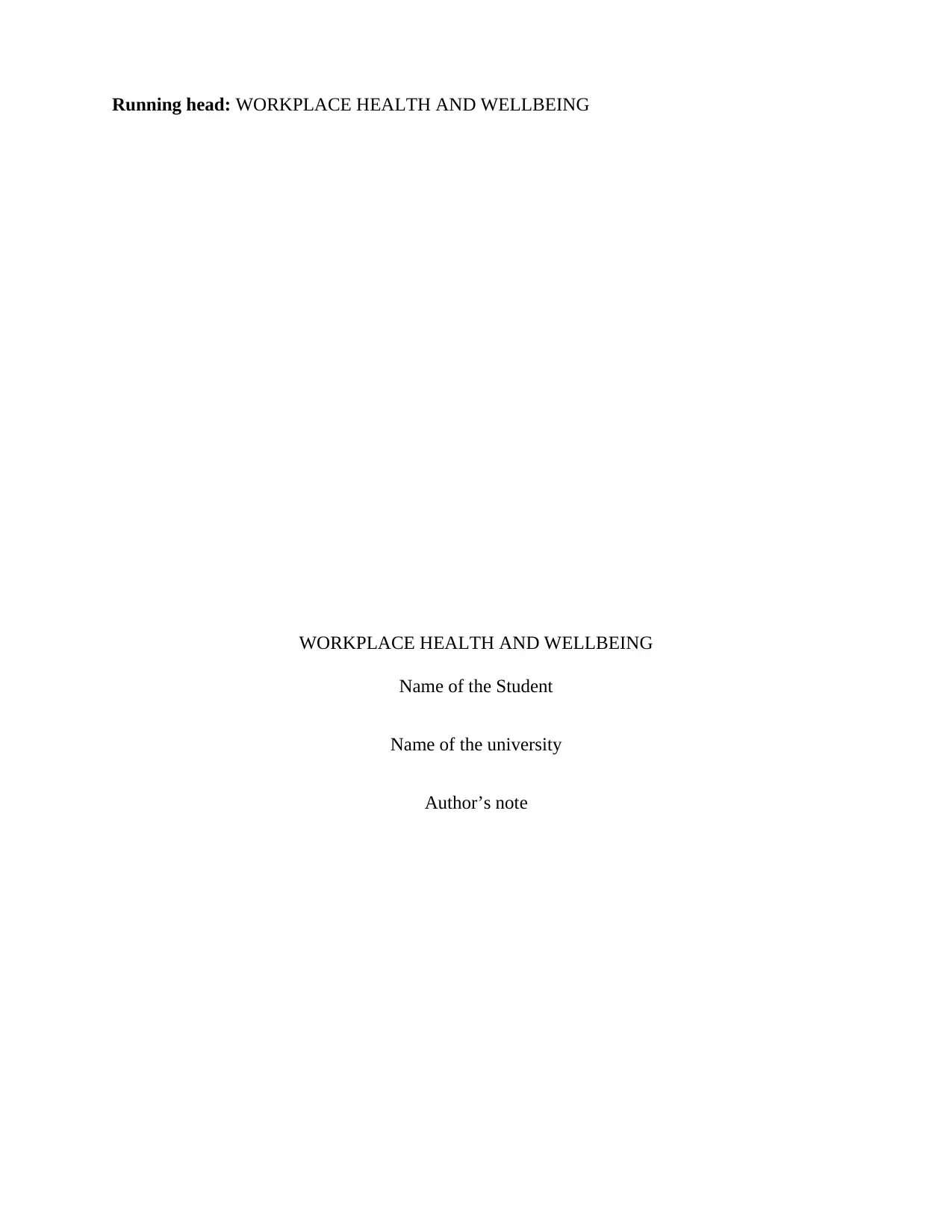
Running head: WORKPLACE HEALTH AND WELLBEING
WORKPLACE HEALTH AND WELLBEING
Name of the Student
Name of the university
Author’s note
WORKPLACE HEALTH AND WELLBEING
Name of the Student
Name of the university
Author’s note
Paraphrase This Document
Need a fresh take? Get an instant paraphrase of this document with our AI Paraphraser
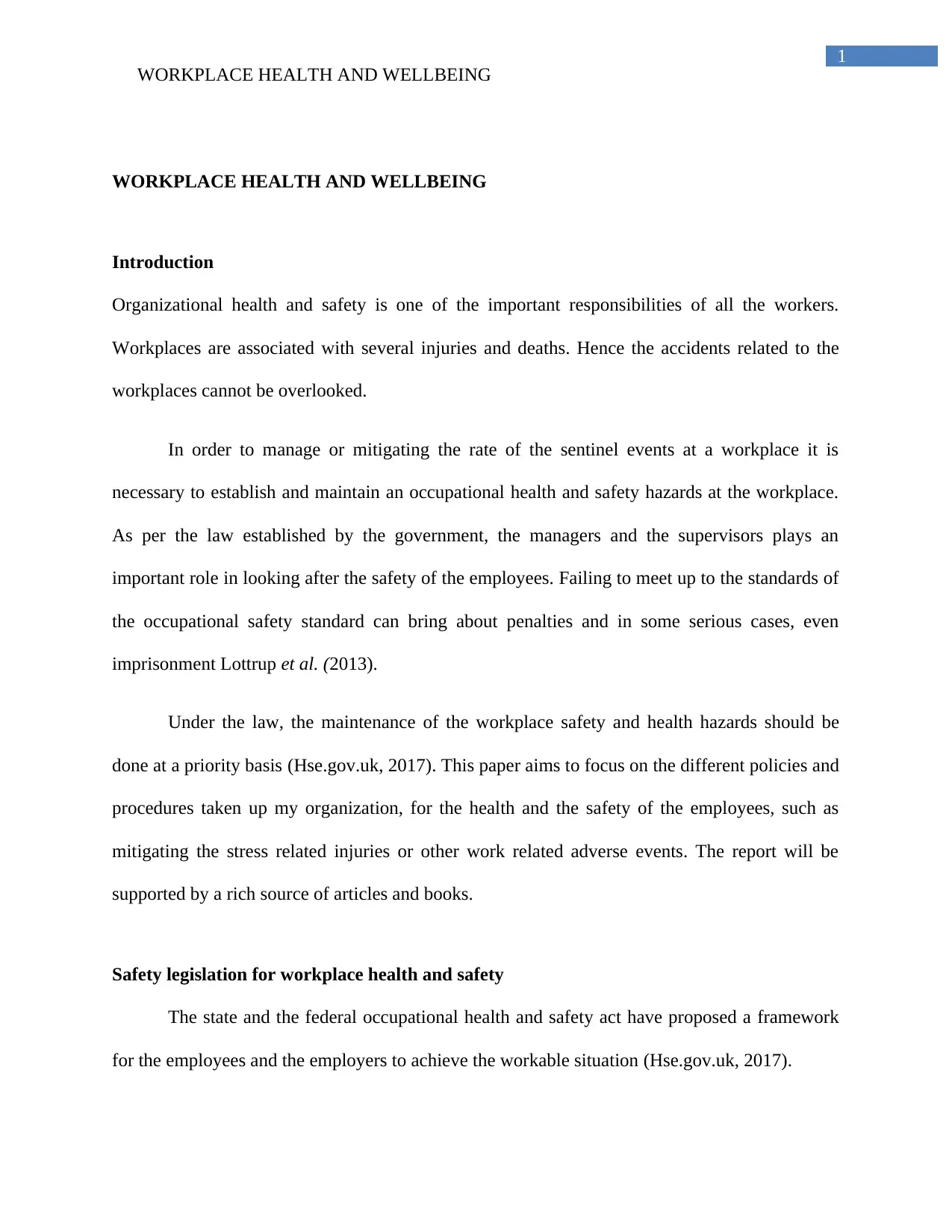
1
WORKPLACE HEALTH AND WELLBEING
WORKPLACE HEALTH AND WELLBEING
Introduction
Organizational health and safety is one of the important responsibilities of all the workers.
Workplaces are associated with several injuries and deaths. Hence the accidents related to the
workplaces cannot be overlooked.
In order to manage or mitigating the rate of the sentinel events at a workplace it is
necessary to establish and maintain an occupational health and safety hazards at the workplace.
As per the law established by the government, the managers and the supervisors plays an
important role in looking after the safety of the employees. Failing to meet up to the standards of
the occupational safety standard can bring about penalties and in some serious cases, even
imprisonment Lottrup et al. (2013).
Under the law, the maintenance of the workplace safety and health hazards should be
done at a priority basis (Hse.gov.uk, 2017). This paper aims to focus on the different policies and
procedures taken up my organization, for the health and the safety of the employees, such as
mitigating the stress related injuries or other work related adverse events. The report will be
supported by a rich source of articles and books.
Safety legislation for workplace health and safety
The state and the federal occupational health and safety act have proposed a framework
for the employees and the employers to achieve the workable situation (Hse.gov.uk, 2017).
WORKPLACE HEALTH AND WELLBEING
WORKPLACE HEALTH AND WELLBEING
Introduction
Organizational health and safety is one of the important responsibilities of all the workers.
Workplaces are associated with several injuries and deaths. Hence the accidents related to the
workplaces cannot be overlooked.
In order to manage or mitigating the rate of the sentinel events at a workplace it is
necessary to establish and maintain an occupational health and safety hazards at the workplace.
As per the law established by the government, the managers and the supervisors plays an
important role in looking after the safety of the employees. Failing to meet up to the standards of
the occupational safety standard can bring about penalties and in some serious cases, even
imprisonment Lottrup et al. (2013).
Under the law, the maintenance of the workplace safety and health hazards should be
done at a priority basis (Hse.gov.uk, 2017). This paper aims to focus on the different policies and
procedures taken up my organization, for the health and the safety of the employees, such as
mitigating the stress related injuries or other work related adverse events. The report will be
supported by a rich source of articles and books.
Safety legislation for workplace health and safety
The state and the federal occupational health and safety act have proposed a framework
for the employees and the employers to achieve the workable situation (Hse.gov.uk, 2017).

2
WORKPLACE HEALTH AND WELLBEING
The key components of the legislation are-
Protection to each of the employees
No right to endanger the life of the workers.
Penalties for the defaulters, violating the norms.
According to Lottrup et al. (2013), legislation mainly emphasizes on the outcomes that the
norms will bring about in the patients rather than simply implementing laws. There are
provisions of in spot fines and penalties for not following the rules and the norms regarding the
safety of the employees.
Some of the essential policy areas regarding workplace safety are related to first aid,
hazardous substances, training to the employees, manual handling, reporting of accidents,
diseases and injuries, fire and emergency evacuation (Kniesner and Leeth, 2012). Stress related
injuries are one of the problems related to work place that can hamper the productivity of an
organization as well as it hamper the workforce. A bit of stress stays an employee to stay focused
and energetic or alert. Tight deadlines and long hours can make an employee feel drained. The
HSE has identified seven categories for work related stress. Culture issues, poor communication
among the employees, long hours are one of the driving factors of stress. Others can be identified
as work overload, poor physical environment (Hse.gov.uk, 2017).
How can stress among the workers harm an organization?
The company that has been taken into account in this paper is a construction company where the
workers are subjected to extreme heat and stress. There can be many unwanted mishaps that can
hamper the workforce of the company.
WORKPLACE HEALTH AND WELLBEING
The key components of the legislation are-
Protection to each of the employees
No right to endanger the life of the workers.
Penalties for the defaulters, violating the norms.
According to Lottrup et al. (2013), legislation mainly emphasizes on the outcomes that the
norms will bring about in the patients rather than simply implementing laws. There are
provisions of in spot fines and penalties for not following the rules and the norms regarding the
safety of the employees.
Some of the essential policy areas regarding workplace safety are related to first aid,
hazardous substances, training to the employees, manual handling, reporting of accidents,
diseases and injuries, fire and emergency evacuation (Kniesner and Leeth, 2012). Stress related
injuries are one of the problems related to work place that can hamper the productivity of an
organization as well as it hamper the workforce. A bit of stress stays an employee to stay focused
and energetic or alert. Tight deadlines and long hours can make an employee feel drained. The
HSE has identified seven categories for work related stress. Culture issues, poor communication
among the employees, long hours are one of the driving factors of stress. Others can be identified
as work overload, poor physical environment (Hse.gov.uk, 2017).
How can stress among the workers harm an organization?
The company that has been taken into account in this paper is a construction company where the
workers are subjected to extreme heat and stress. There can be many unwanted mishaps that can
hamper the workforce of the company.
⊘ This is a preview!⊘
Do you want full access?
Subscribe today to unlock all pages.

Trusted by 1+ million students worldwide
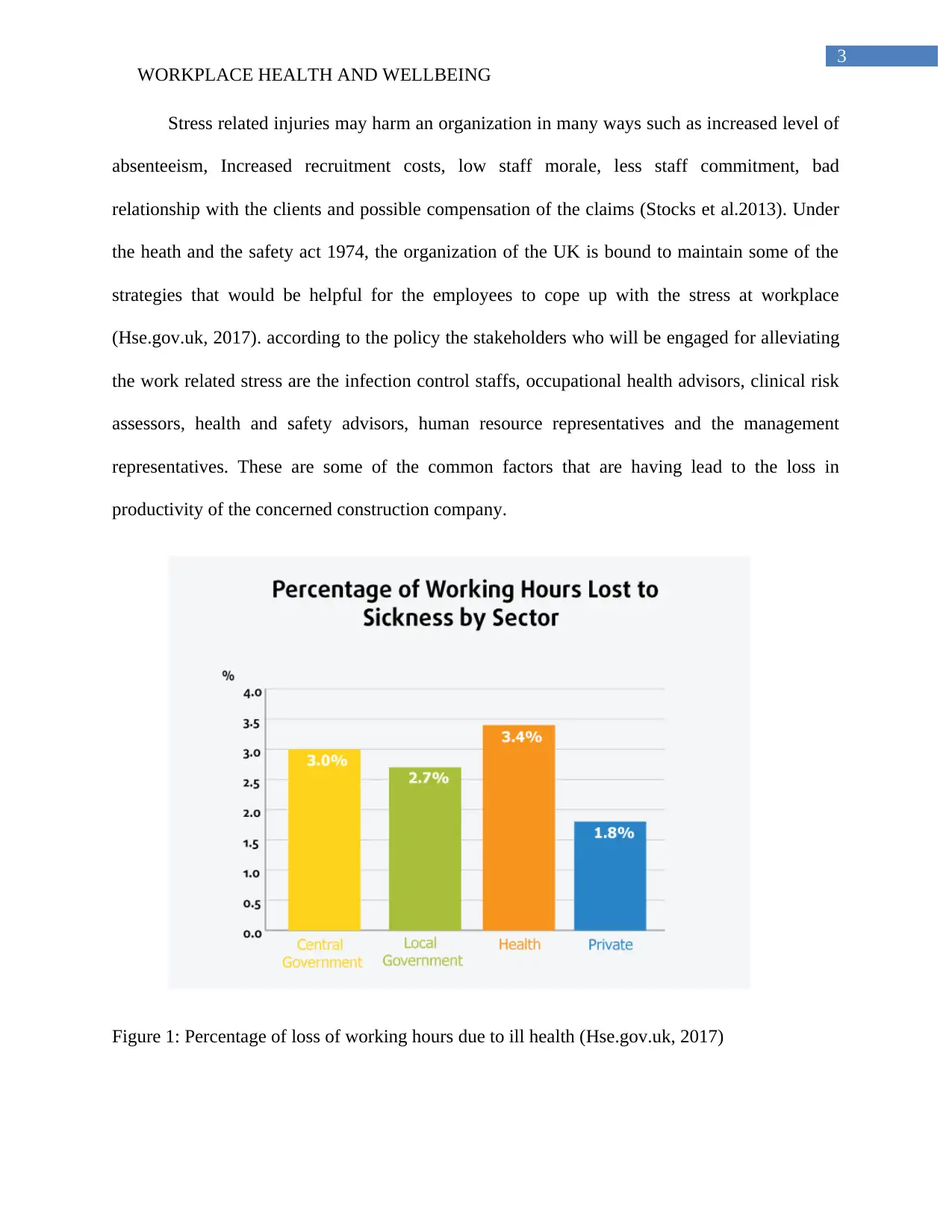
3
WORKPLACE HEALTH AND WELLBEING
Stress related injuries may harm an organization in many ways such as increased level of
absenteeism, Increased recruitment costs, low staff morale, less staff commitment, bad
relationship with the clients and possible compensation of the claims (Stocks et al.2013). Under
the heath and the safety act 1974, the organization of the UK is bound to maintain some of the
strategies that would be helpful for the employees to cope up with the stress at workplace
(Hse.gov.uk, 2017). according to the policy the stakeholders who will be engaged for alleviating
the work related stress are the infection control staffs, occupational health advisors, clinical risk
assessors, health and safety advisors, human resource representatives and the management
representatives. These are some of the common factors that are having lead to the loss in
productivity of the concerned construction company.
Figure 1: Percentage of loss of working hours due to ill health (Hse.gov.uk, 2017)
WORKPLACE HEALTH AND WELLBEING
Stress related injuries may harm an organization in many ways such as increased level of
absenteeism, Increased recruitment costs, low staff morale, less staff commitment, bad
relationship with the clients and possible compensation of the claims (Stocks et al.2013). Under
the heath and the safety act 1974, the organization of the UK is bound to maintain some of the
strategies that would be helpful for the employees to cope up with the stress at workplace
(Hse.gov.uk, 2017). according to the policy the stakeholders who will be engaged for alleviating
the work related stress are the infection control staffs, occupational health advisors, clinical risk
assessors, health and safety advisors, human resource representatives and the management
representatives. These are some of the common factors that are having lead to the loss in
productivity of the concerned construction company.
Figure 1: Percentage of loss of working hours due to ill health (Hse.gov.uk, 2017)
Paraphrase This Document
Need a fresh take? Get an instant paraphrase of this document with our AI Paraphraser
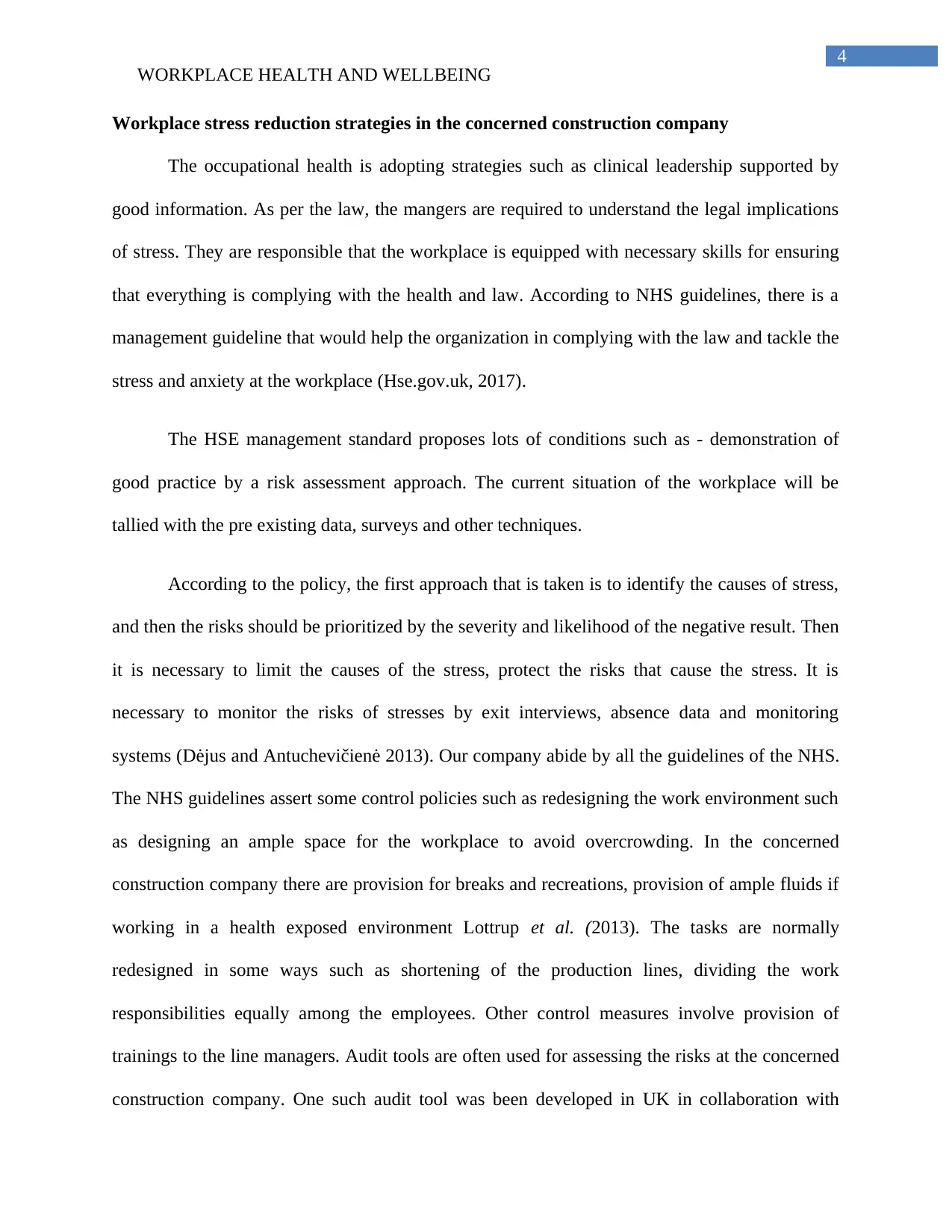
4
WORKPLACE HEALTH AND WELLBEING
Workplace stress reduction strategies in the concerned construction company
The occupational health is adopting strategies such as clinical leadership supported by
good information. As per the law, the mangers are required to understand the legal implications
of stress. They are responsible that the workplace is equipped with necessary skills for ensuring
that everything is complying with the health and law. According to NHS guidelines, there is a
management guideline that would help the organization in complying with the law and tackle the
stress and anxiety at the workplace (Hse.gov.uk, 2017).
The HSE management standard proposes lots of conditions such as - demonstration of
good practice by a risk assessment approach. The current situation of the workplace will be
tallied with the pre existing data, surveys and other techniques.
According to the policy, the first approach that is taken is to identify the causes of stress,
and then the risks should be prioritized by the severity and likelihood of the negative result. Then
it is necessary to limit the causes of the stress, protect the risks that cause the stress. It is
necessary to monitor the risks of stresses by exit interviews, absence data and monitoring
systems (Dėjus and Antuchevičienė 2013). Our company abide by all the guidelines of the NHS.
The NHS guidelines assert some control policies such as redesigning the work environment such
as designing an ample space for the workplace to avoid overcrowding. In the concerned
construction company there are provision for breaks and recreations, provision of ample fluids if
working in a health exposed environment Lottrup et al. (2013). The tasks are normally
redesigned in some ways such as shortening of the production lines, dividing the work
responsibilities equally among the employees. Other control measures involve provision of
trainings to the line managers. Audit tools are often used for assessing the risks at the concerned
construction company. One such audit tool was been developed in UK in collaboration with
WORKPLACE HEALTH AND WELLBEING
Workplace stress reduction strategies in the concerned construction company
The occupational health is adopting strategies such as clinical leadership supported by
good information. As per the law, the mangers are required to understand the legal implications
of stress. They are responsible that the workplace is equipped with necessary skills for ensuring
that everything is complying with the health and law. According to NHS guidelines, there is a
management guideline that would help the organization in complying with the law and tackle the
stress and anxiety at the workplace (Hse.gov.uk, 2017).
The HSE management standard proposes lots of conditions such as - demonstration of
good practice by a risk assessment approach. The current situation of the workplace will be
tallied with the pre existing data, surveys and other techniques.
According to the policy, the first approach that is taken is to identify the causes of stress,
and then the risks should be prioritized by the severity and likelihood of the negative result. Then
it is necessary to limit the causes of the stress, protect the risks that cause the stress. It is
necessary to monitor the risks of stresses by exit interviews, absence data and monitoring
systems (Dėjus and Antuchevičienė 2013). Our company abide by all the guidelines of the NHS.
The NHS guidelines assert some control policies such as redesigning the work environment such
as designing an ample space for the workplace to avoid overcrowding. In the concerned
construction company there are provision for breaks and recreations, provision of ample fluids if
working in a health exposed environment Lottrup et al. (2013). The tasks are normally
redesigned in some ways such as shortening of the production lines, dividing the work
responsibilities equally among the employees. Other control measures involve provision of
trainings to the line managers. Audit tools are often used for assessing the risks at the concerned
construction company. One such audit tool was been developed in UK in collaboration with
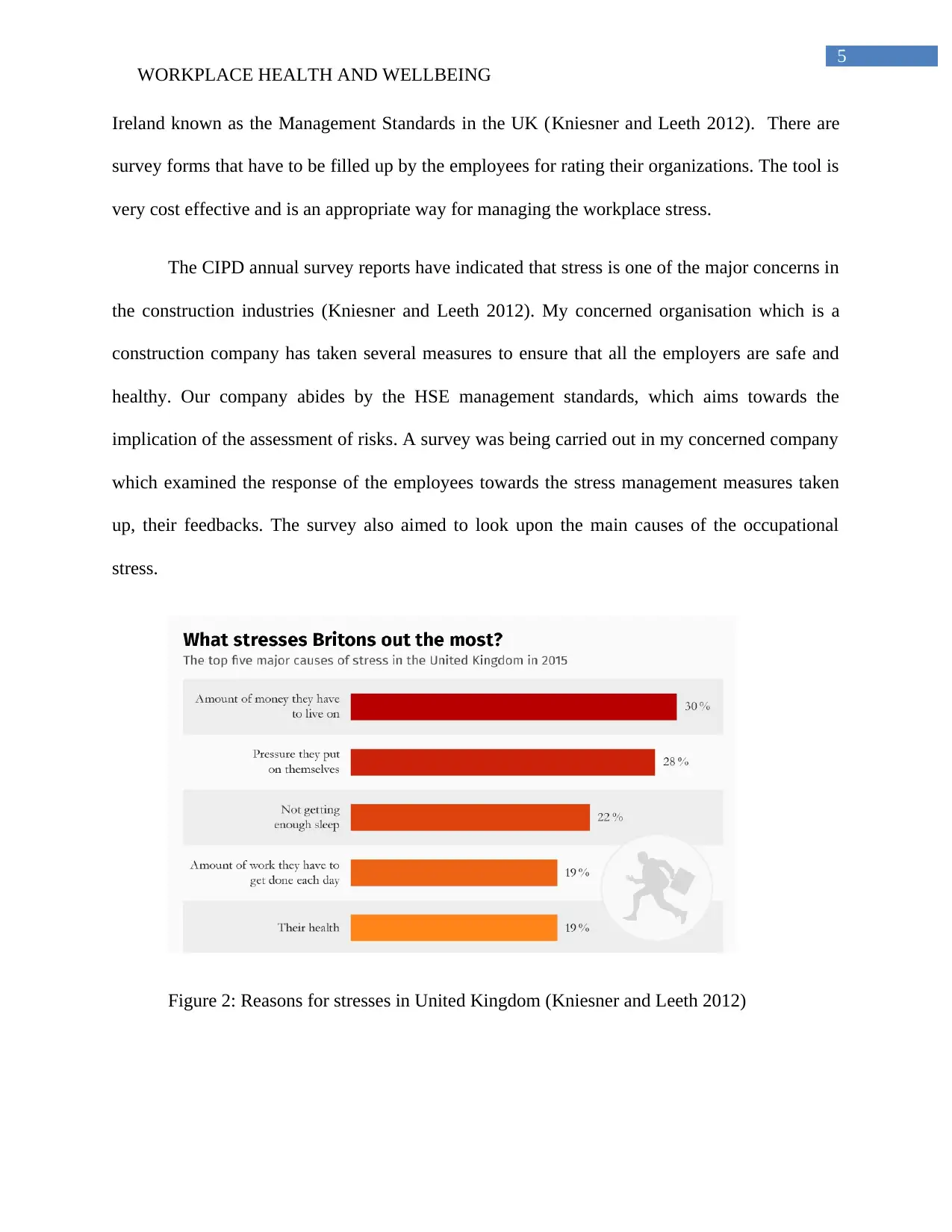
5
WORKPLACE HEALTH AND WELLBEING
Ireland known as the Management Standards in the UK (Kniesner and Leeth 2012). There are
survey forms that have to be filled up by the employees for rating their organizations. The tool is
very cost effective and is an appropriate way for managing the workplace stress.
The CIPD annual survey reports have indicated that stress is one of the major concerns in
the construction industries (Kniesner and Leeth 2012). My concerned organisation which is a
construction company has taken several measures to ensure that all the employers are safe and
healthy. Our company abides by the HSE management standards, which aims towards the
implication of the assessment of risks. A survey was being carried out in my concerned company
which examined the response of the employees towards the stress management measures taken
up, their feedbacks. The survey also aimed to look upon the main causes of the occupational
stress.
Figure 2: Reasons for stresses in United Kingdom (Kniesner and Leeth 2012)
WORKPLACE HEALTH AND WELLBEING
Ireland known as the Management Standards in the UK (Kniesner and Leeth 2012). There are
survey forms that have to be filled up by the employees for rating their organizations. The tool is
very cost effective and is an appropriate way for managing the workplace stress.
The CIPD annual survey reports have indicated that stress is one of the major concerns in
the construction industries (Kniesner and Leeth 2012). My concerned organisation which is a
construction company has taken several measures to ensure that all the employers are safe and
healthy. Our company abides by the HSE management standards, which aims towards the
implication of the assessment of risks. A survey was being carried out in my concerned company
which examined the response of the employees towards the stress management measures taken
up, their feedbacks. The survey also aimed to look upon the main causes of the occupational
stress.
Figure 2: Reasons for stresses in United Kingdom (Kniesner and Leeth 2012)
⊘ This is a preview!⊘
Do you want full access?
Subscribe today to unlock all pages.

Trusted by 1+ million students worldwide
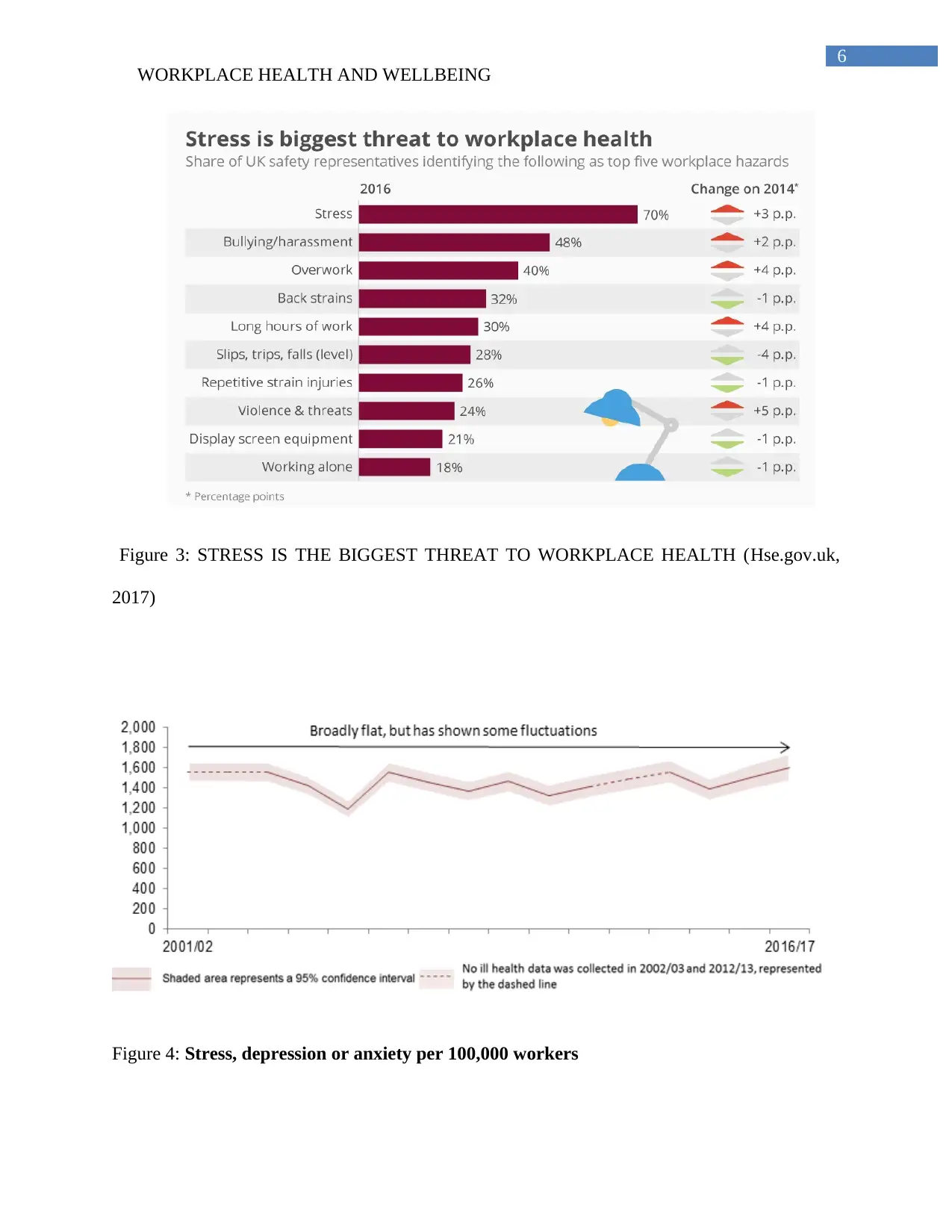
6
WORKPLACE HEALTH AND WELLBEING
Figure 3: STRESS IS THE BIGGEST THREAT TO WORKPLACE HEALTH (Hse.gov.uk,
2017)
Figure 4: Stress, depression or anxiety per 100,000 workers
WORKPLACE HEALTH AND WELLBEING
Figure 3: STRESS IS THE BIGGEST THREAT TO WORKPLACE HEALTH (Hse.gov.uk,
2017)
Figure 4: Stress, depression or anxiety per 100,000 workers
Paraphrase This Document
Need a fresh take? Get an instant paraphrase of this document with our AI Paraphraser
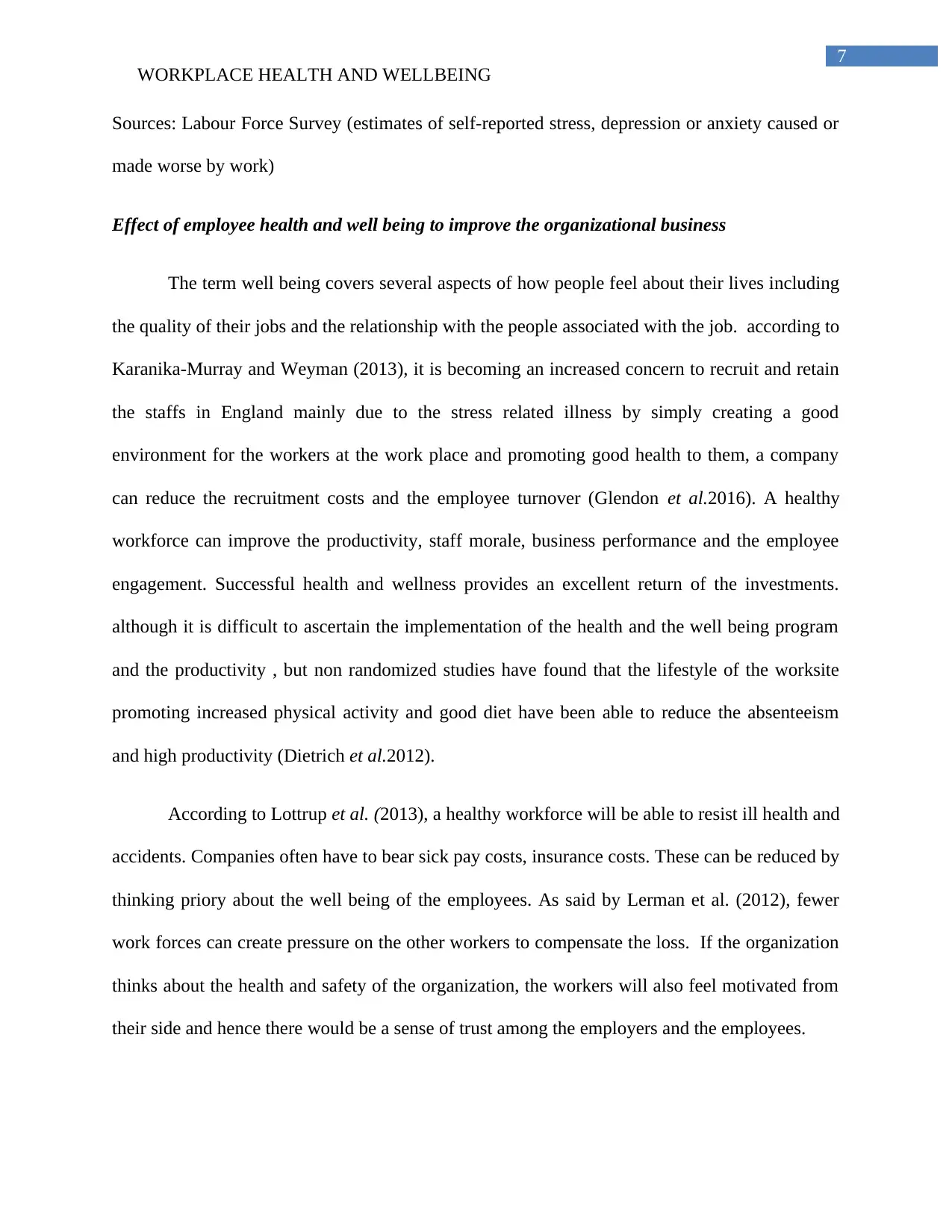
7
WORKPLACE HEALTH AND WELLBEING
Sources: Labour Force Survey (estimates of self-reported stress, depression or anxiety caused or
made worse by work)
Effect of employee health and well being to improve the organizational business
The term well being covers several aspects of how people feel about their lives including
the quality of their jobs and the relationship with the people associated with the job. according to
Karanika-Murray and Weyman (2013), it is becoming an increased concern to recruit and retain
the staffs in England mainly due to the stress related illness by simply creating a good
environment for the workers at the work place and promoting good health to them, a company
can reduce the recruitment costs and the employee turnover (Glendon et al.2016). A healthy
workforce can improve the productivity, staff morale, business performance and the employee
engagement. Successful health and wellness provides an excellent return of the investments.
although it is difficult to ascertain the implementation of the health and the well being program
and the productivity , but non randomized studies have found that the lifestyle of the worksite
promoting increased physical activity and good diet have been able to reduce the absenteeism
and high productivity (Dietrich et al.2012).
According to Lottrup et al. (2013), a healthy workforce will be able to resist ill health and
accidents. Companies often have to bear sick pay costs, insurance costs. These can be reduced by
thinking priory about the well being of the employees. As said by Lerman et al. (2012), fewer
work forces can create pressure on the other workers to compensate the loss. If the organization
thinks about the health and safety of the organization, the workers will also feel motivated from
their side and hence there would be a sense of trust among the employers and the employees.
WORKPLACE HEALTH AND WELLBEING
Sources: Labour Force Survey (estimates of self-reported stress, depression or anxiety caused or
made worse by work)
Effect of employee health and well being to improve the organizational business
The term well being covers several aspects of how people feel about their lives including
the quality of their jobs and the relationship with the people associated with the job. according to
Karanika-Murray and Weyman (2013), it is becoming an increased concern to recruit and retain
the staffs in England mainly due to the stress related illness by simply creating a good
environment for the workers at the work place and promoting good health to them, a company
can reduce the recruitment costs and the employee turnover (Glendon et al.2016). A healthy
workforce can improve the productivity, staff morale, business performance and the employee
engagement. Successful health and wellness provides an excellent return of the investments.
although it is difficult to ascertain the implementation of the health and the well being program
and the productivity , but non randomized studies have found that the lifestyle of the worksite
promoting increased physical activity and good diet have been able to reduce the absenteeism
and high productivity (Dietrich et al.2012).
According to Lottrup et al. (2013), a healthy workforce will be able to resist ill health and
accidents. Companies often have to bear sick pay costs, insurance costs. These can be reduced by
thinking priory about the well being of the employees. As said by Lerman et al. (2012), fewer
work forces can create pressure on the other workers to compensate the loss. If the organization
thinks about the health and safety of the organization, the workers will also feel motivated from
their side and hence there would be a sense of trust among the employers and the employees.
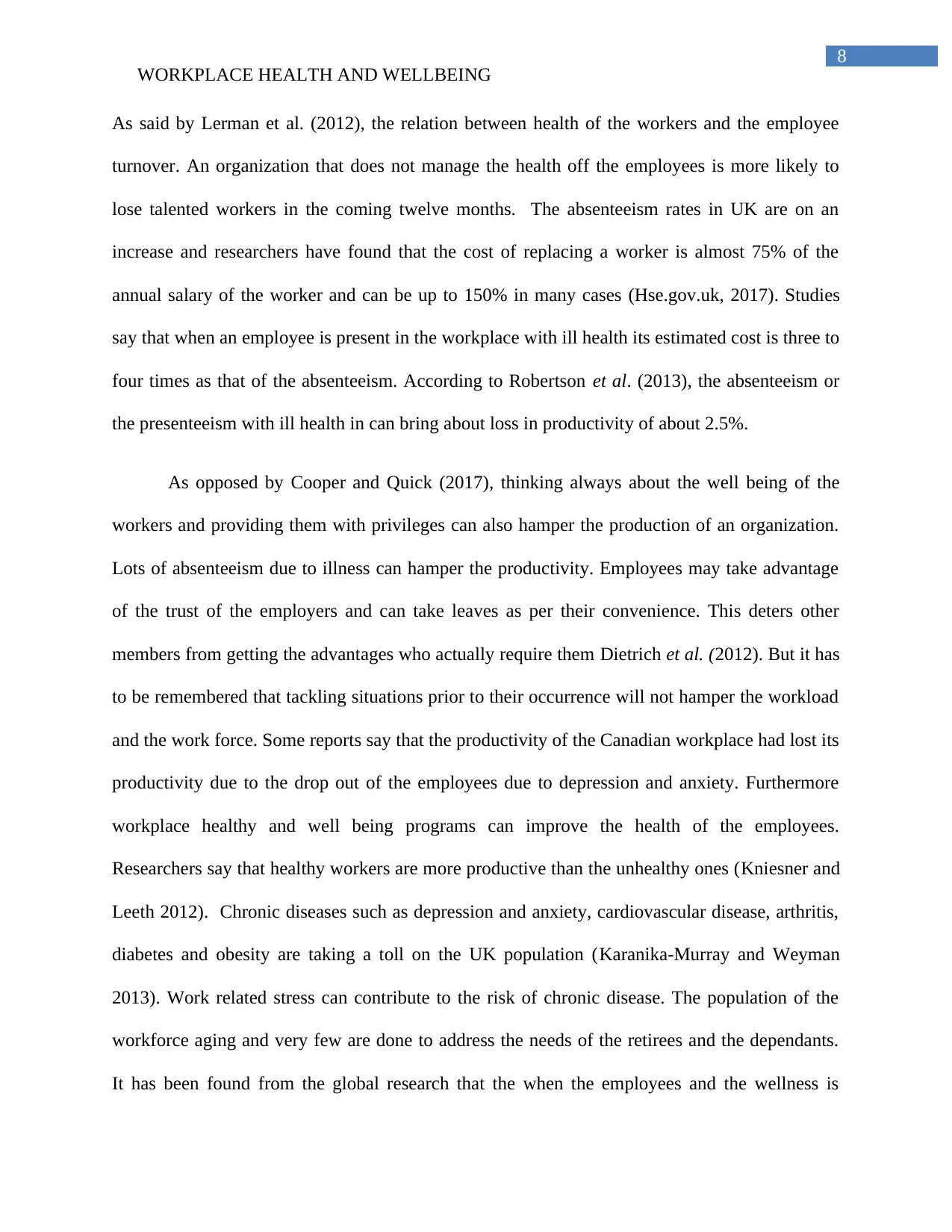
8
WORKPLACE HEALTH AND WELLBEING
As said by Lerman et al. (2012), the relation between health of the workers and the employee
turnover. An organization that does not manage the health off the employees is more likely to
lose talented workers in the coming twelve months. The absenteeism rates in UK are on an
increase and researchers have found that the cost of replacing a worker is almost 75% of the
annual salary of the worker and can be up to 150% in many cases (Hse.gov.uk, 2017). Studies
say that when an employee is present in the workplace with ill health its estimated cost is three to
four times as that of the absenteeism. According to Robertson et al. (2013), the absenteeism or
the presenteeism with ill health in can bring about loss in productivity of about 2.5%.
As opposed by Cooper and Quick (2017), thinking always about the well being of the
workers and providing them with privileges can also hamper the production of an organization.
Lots of absenteeism due to illness can hamper the productivity. Employees may take advantage
of the trust of the employers and can take leaves as per their convenience. This deters other
members from getting the advantages who actually require them Dietrich et al. (2012). But it has
to be remembered that tackling situations prior to their occurrence will not hamper the workload
and the work force. Some reports say that the productivity of the Canadian workplace had lost its
productivity due to the drop out of the employees due to depression and anxiety. Furthermore
workplace healthy and well being programs can improve the health of the employees.
Researchers say that healthy workers are more productive than the unhealthy ones (Kniesner and
Leeth 2012). Chronic diseases such as depression and anxiety, cardiovascular disease, arthritis,
diabetes and obesity are taking a toll on the UK population (Karanika-Murray and Weyman
2013). Work related stress can contribute to the risk of chronic disease. The population of the
workforce aging and very few are done to address the needs of the retirees and the dependants.
It has been found from the global research that the when the employees and the wellness is
WORKPLACE HEALTH AND WELLBEING
As said by Lerman et al. (2012), the relation between health of the workers and the employee
turnover. An organization that does not manage the health off the employees is more likely to
lose talented workers in the coming twelve months. The absenteeism rates in UK are on an
increase and researchers have found that the cost of replacing a worker is almost 75% of the
annual salary of the worker and can be up to 150% in many cases (Hse.gov.uk, 2017). Studies
say that when an employee is present in the workplace with ill health its estimated cost is three to
four times as that of the absenteeism. According to Robertson et al. (2013), the absenteeism or
the presenteeism with ill health in can bring about loss in productivity of about 2.5%.
As opposed by Cooper and Quick (2017), thinking always about the well being of the
workers and providing them with privileges can also hamper the production of an organization.
Lots of absenteeism due to illness can hamper the productivity. Employees may take advantage
of the trust of the employers and can take leaves as per their convenience. This deters other
members from getting the advantages who actually require them Dietrich et al. (2012). But it has
to be remembered that tackling situations prior to their occurrence will not hamper the workload
and the work force. Some reports say that the productivity of the Canadian workplace had lost its
productivity due to the drop out of the employees due to depression and anxiety. Furthermore
workplace healthy and well being programs can improve the health of the employees.
Researchers say that healthy workers are more productive than the unhealthy ones (Kniesner and
Leeth 2012). Chronic diseases such as depression and anxiety, cardiovascular disease, arthritis,
diabetes and obesity are taking a toll on the UK population (Karanika-Murray and Weyman
2013). Work related stress can contribute to the risk of chronic disease. The population of the
workforce aging and very few are done to address the needs of the retirees and the dependants.
It has been found from the global research that the when the employees and the wellness is
⊘ This is a preview!⊘
Do you want full access?
Subscribe today to unlock all pages.

Trusted by 1+ million students worldwide
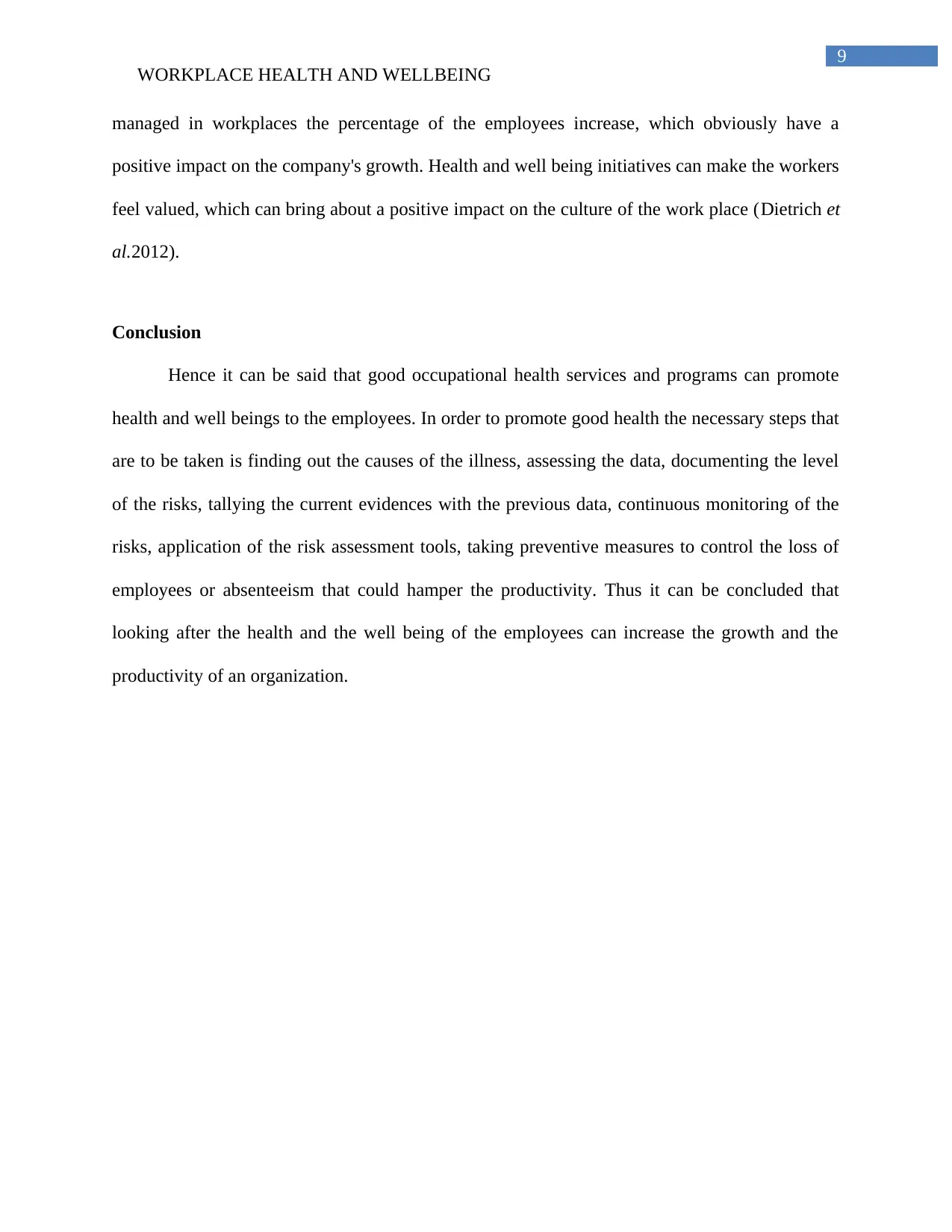
9
WORKPLACE HEALTH AND WELLBEING
managed in workplaces the percentage of the employees increase, which obviously have a
positive impact on the company's growth. Health and well being initiatives can make the workers
feel valued, which can bring about a positive impact on the culture of the work place (Dietrich et
al.2012).
Conclusion
Hence it can be said that good occupational health services and programs can promote
health and well beings to the employees. In order to promote good health the necessary steps that
are to be taken is finding out the causes of the illness, assessing the data, documenting the level
of the risks, tallying the current evidences with the previous data, continuous monitoring of the
risks, application of the risk assessment tools, taking preventive measures to control the loss of
employees or absenteeism that could hamper the productivity. Thus it can be concluded that
looking after the health and the well being of the employees can increase the growth and the
productivity of an organization.
WORKPLACE HEALTH AND WELLBEING
managed in workplaces the percentage of the employees increase, which obviously have a
positive impact on the company's growth. Health and well being initiatives can make the workers
feel valued, which can bring about a positive impact on the culture of the work place (Dietrich et
al.2012).
Conclusion
Hence it can be said that good occupational health services and programs can promote
health and well beings to the employees. In order to promote good health the necessary steps that
are to be taken is finding out the causes of the illness, assessing the data, documenting the level
of the risks, tallying the current evidences with the previous data, continuous monitoring of the
risks, application of the risk assessment tools, taking preventive measures to control the loss of
employees or absenteeism that could hamper the productivity. Thus it can be concluded that
looking after the health and the well being of the employees can increase the growth and the
productivity of an organization.
Paraphrase This Document
Need a fresh take? Get an instant paraphrase of this document with our AI Paraphraser
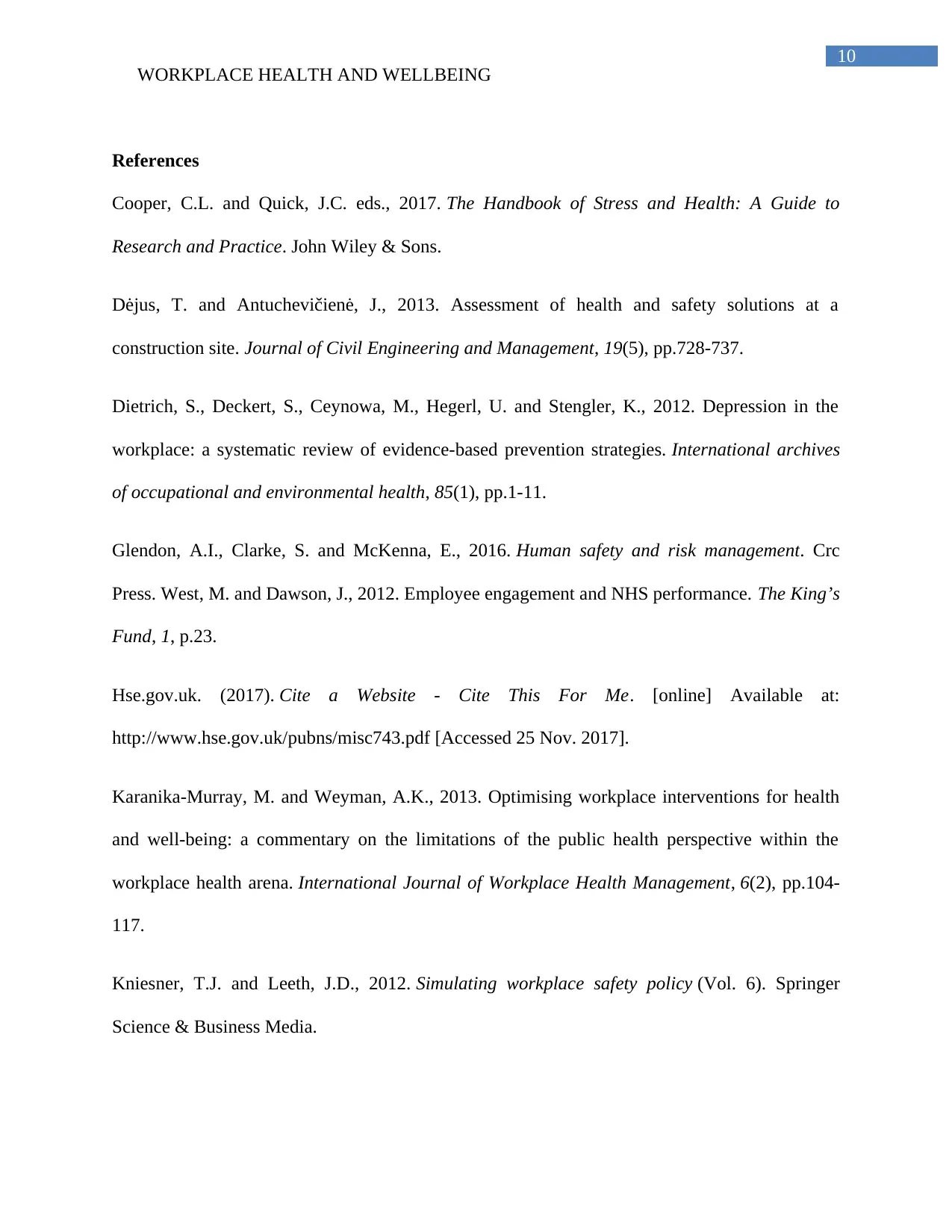
10
WORKPLACE HEALTH AND WELLBEING
References
Cooper, C.L. and Quick, J.C. eds., 2017. The Handbook of Stress and Health: A Guide to
Research and Practice. John Wiley & Sons.
Dėjus, T. and Antuchevičienė, J., 2013. Assessment of health and safety solutions at a
construction site. Journal of Civil Engineering and Management, 19(5), pp.728-737.
Dietrich, S., Deckert, S., Ceynowa, M., Hegerl, U. and Stengler, K., 2012. Depression in the
workplace: a systematic review of evidence-based prevention strategies. International archives
of occupational and environmental health, 85(1), pp.1-11.
Glendon, A.I., Clarke, S. and McKenna, E., 2016. Human safety and risk management. Crc
Press. West, M. and Dawson, J., 2012. Employee engagement and NHS performance. The King’s
Fund, 1, p.23.
Hse.gov.uk. (2017). Cite a Website - Cite This For Me. [online] Available at:
http://www.hse.gov.uk/pubns/misc743.pdf [Accessed 25 Nov. 2017].
Karanika-Murray, M. and Weyman, A.K., 2013. Optimising workplace interventions for health
and well-being: a commentary on the limitations of the public health perspective within the
workplace health arena. International Journal of Workplace Health Management, 6(2), pp.104-
117.
Kniesner, T.J. and Leeth, J.D., 2012. Simulating workplace safety policy (Vol. 6). Springer
Science & Business Media.
WORKPLACE HEALTH AND WELLBEING
References
Cooper, C.L. and Quick, J.C. eds., 2017. The Handbook of Stress and Health: A Guide to
Research and Practice. John Wiley & Sons.
Dėjus, T. and Antuchevičienė, J., 2013. Assessment of health and safety solutions at a
construction site. Journal of Civil Engineering and Management, 19(5), pp.728-737.
Dietrich, S., Deckert, S., Ceynowa, M., Hegerl, U. and Stengler, K., 2012. Depression in the
workplace: a systematic review of evidence-based prevention strategies. International archives
of occupational and environmental health, 85(1), pp.1-11.
Glendon, A.I., Clarke, S. and McKenna, E., 2016. Human safety and risk management. Crc
Press. West, M. and Dawson, J., 2012. Employee engagement and NHS performance. The King’s
Fund, 1, p.23.
Hse.gov.uk. (2017). Cite a Website - Cite This For Me. [online] Available at:
http://www.hse.gov.uk/pubns/misc743.pdf [Accessed 25 Nov. 2017].
Karanika-Murray, M. and Weyman, A.K., 2013. Optimising workplace interventions for health
and well-being: a commentary on the limitations of the public health perspective within the
workplace health arena. International Journal of Workplace Health Management, 6(2), pp.104-
117.
Kniesner, T.J. and Leeth, J.D., 2012. Simulating workplace safety policy (Vol. 6). Springer
Science & Business Media.

11
WORKPLACE HEALTH AND WELLBEING
Lerman, S.E., Eskin, E., Flower, D.J., George, E.C., Gerson, B., Hartenbaum, N., Hursh, S.R.
and Moore-Ede, M., 2012. Fatigue risk management in the workplace. Journal of Occupational
and Environmental Medicine, 54(2), pp.231-258.
Lottrup, L., Grahn, P. and Stigsdotter, U.K., 2013. Workplace greenery and perceived level of
stress: Benefits of access to a green outdoor environment at the workplace. Landscape and
Urban Planning, 110, pp.5-11.
Robertson, M., Henning, R., Warren, N., Nobrega, S., Dove-Steinkamp, M., Tibirica, L.,
Bizarro, A. and CPH-NEW Research Team, 2013. The intervention design and analysis
scorecard: A planning tool for participatory design of integrated health and safety interventions
in the workplace. Journal of Occupational and Environmental Medicine, 55, pp.S86-S88.
Schulte, P.A., Guerin, R.J., Schill, A.L., Bhattacharya, A., Cunningham, T.R., Pandalai, S.P.,
Eggerth, D. and Stephenson, C.M., 2015. Considerations for incorporating “well-being” in public
policy for workers and workplaces. American journal of public health, 105(8), pp.e31-e44.
Stocks, S.J., McNamee, R., Turner, S., Carder, M. and Agius, R.M., 2013. Assessing the impact
of national level interventions on workplace respiratory disease in the UK: part 2—regulatory
activity by the Health and Safety Executive. Occup Environ Med, pp.oemed-2012.
WORKPLACE HEALTH AND WELLBEING
Lerman, S.E., Eskin, E., Flower, D.J., George, E.C., Gerson, B., Hartenbaum, N., Hursh, S.R.
and Moore-Ede, M., 2012. Fatigue risk management in the workplace. Journal of Occupational
and Environmental Medicine, 54(2), pp.231-258.
Lottrup, L., Grahn, P. and Stigsdotter, U.K., 2013. Workplace greenery and perceived level of
stress: Benefits of access to a green outdoor environment at the workplace. Landscape and
Urban Planning, 110, pp.5-11.
Robertson, M., Henning, R., Warren, N., Nobrega, S., Dove-Steinkamp, M., Tibirica, L.,
Bizarro, A. and CPH-NEW Research Team, 2013. The intervention design and analysis
scorecard: A planning tool for participatory design of integrated health and safety interventions
in the workplace. Journal of Occupational and Environmental Medicine, 55, pp.S86-S88.
Schulte, P.A., Guerin, R.J., Schill, A.L., Bhattacharya, A., Cunningham, T.R., Pandalai, S.P.,
Eggerth, D. and Stephenson, C.M., 2015. Considerations for incorporating “well-being” in public
policy for workers and workplaces. American journal of public health, 105(8), pp.e31-e44.
Stocks, S.J., McNamee, R., Turner, S., Carder, M. and Agius, R.M., 2013. Assessing the impact
of national level interventions on workplace respiratory disease in the UK: part 2—regulatory
activity by the Health and Safety Executive. Occup Environ Med, pp.oemed-2012.
⊘ This is a preview!⊘
Do you want full access?
Subscribe today to unlock all pages.

Trusted by 1+ million students worldwide
1 out of 12
Related Documents
Your All-in-One AI-Powered Toolkit for Academic Success.
+13062052269
info@desklib.com
Available 24*7 on WhatsApp / Email
![[object Object]](/_next/static/media/star-bottom.7253800d.svg)
Unlock your academic potential
Copyright © 2020–2025 A2Z Services. All Rights Reserved. Developed and managed by ZUCOL.



